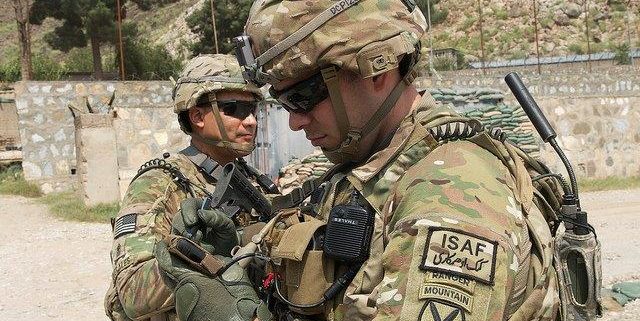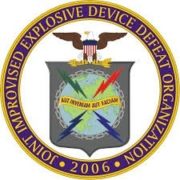 When I researched this article about Counter Improvised Explosive Devices (C-IED) training, I couldn’t help thinking about communities near Tijuana in which the the homes are built out of discarded garage doors. Garage doors aren’t the first thing anyone thinks of when building a house, but the people near the border didn’t have building materials. So, they looked around and found what was available: discarded garage doors.
When I researched this article about Counter Improvised Explosive Devices (C-IED) training, I couldn’t help thinking about communities near Tijuana in which the the homes are built out of discarded garage doors. Garage doors aren’t the first thing anyone thinks of when building a house, but the people near the border didn’t have building materials. So, they looked around and found what was available: discarded garage doors.
Similarly, the military has a problem: training. As the land wars wind down in Asia (sort of), training domestically becomes more important. Simultaneously, training budgets are being squeezed. Future operational goals are unpredictable, so training for diverse scenarios is necessary. Live training is expensive, so more has to be done with less. Rapid technological change means rapid change in doctrine and tactics. It is important that feedback from ongoing missions be incorporated as soon as possible into training.
Just like the folks in Tijuana, the military looked around for available materials to solve their problems. What they found were mobile devices. Just like garage doors are not normally associated as the basic building materials for houses, nobody in boot camp ever told a soldier that their best friend is their smart phone.
So far, mobile devices have proven to be a pretty good fit. Mobile devices are excellent platforms for virtual programs, videos, interactive simulation systems, and smart books. Familiarity with specialized military apps allows the soldier to seamlessly transition to operations in which mobile devices are used as lightweight, mobile repositories for doctrinal manuals, as well as maintenance & technical manuals. They can even be used for educational games (in the past soldiers learned to identify soviet aircraft from specially designed playing cards).
Their single most important quality of mobile devices is that they are dynamic. No more paper manuals or books that are outdated by the time they are printed. Mobile devices can be updated instantly.
The embrace of mobile devices for training reflects a subtle, but meaningful change. The old model of attending a class where a teacher pours knowledge into a soldier’s empty heads is fading. Instead, the soldier is trained to learn. He is given personal responsibility for his education and he is expected to be disciplined about continuously improving his skill sets. He will carry this self-motivated attitude into the field, where he will need to constantly refresh his knowledge. The 24/7, anywhere, anytime nature of mobile devices fits this outlook perfectly.
The old formula to deal with the ever increasing burden of training soldiers was “train the trainer.” The new model may be described as “equip the learner.”
These trends are reflected in counter IED training. Joint Improvised Explosive Device Defeat Organization (JIEDDO) is tasked with countering the “number one killer of Soldiers on the current battlefields worldwide.” As they state on their training webpage, “Because the IED threat is constantly changing, the counter-IED fight is dynamic, and maintaining effectiveness remains an enduring requirement of training solution development.” Just like the rest of the military, JIEDDO has embraced mobile devices as a solution for the need of continuous training.
For the purposes of C-IED training, JIEDDO’s Instructional Technology Development Team (ITDT) developed what it describes as “Digital Learning Content products.” It is telling that these “products” support several types of learning: institutional, operational, and self-development. Just offering these options conveys an important message; a warfighter’s training never ceases.
Through its Joint Center of Excellence, (JCOE), JIEDDO has a small team of personnel located in Afghanistan conducting an exhaustive lessons-learned program. Brigade and regimental combat team staffs are debriefed at 90-day, mid-tour, and post-deployment milestones. Training is updated with relevant information.
Let’s formulate a hypothetical example in which updated information could be critical. The enemy favors planting IEDs on roads a military vehicle has previously used. Currently, warfighters use a map application on their mobile devices to avoid routes that have been already traveled. Suppose the enemy wises up to this tactic? Considering the flexibility and ingenuity they have shown in the past, this is certainly possible. A sudden switch in tactics could make the most-used road the safest one. Thanks to mobile devices, a warfighter can be informed of this life-saving information in real time.
In keeping with the military’s aversion to committing to any specific hardware, these Digital Learning Content products are available on multiple platforms. The Digital Learning Content products described above were deliberately designed to function within a “Bring Your Own Device (BYOD)” environment.
However, as the distinction between training and deployment becomes blurred, the military cannot ignore basic hardware issues. If mobile devices are used for field training (and communication, situational awareness, and other purposes), how secure is it? Is the information on it secure if a soldier is captured with his mobile device? Is a password log-in good enough protection? Is there a software solution that can thoroughly wipe the hard drive if the wrong key combination is pressed? Or does it require a physical anti-tamper device that melts the whole thing down? If it does have wireless and/or Bluetooth, how do you make it hack/virus/malware proof?
The military has focused on creating applications, specifically to avoid committing to one hardware device. Obviously, this is completely impractical for devices carried in theater. Logistics for heterogeneous platforms would be a nightmare.
Which brings us to the critical issue of ruggedness. Commercial mobile devices, such as smartphones, are notoriously fragile. Obviously, fully rugged devices are needed in theater. If training is designed to seamlessly blend from stateside to areas of operations, doesn’t it make sense to use the same mobile device? Rugged mobile devices for domestic training would decrease the amount of downtime due to equipment failure and breakage.
JIEDDO has made significant progress in incorporating mobile devices into their training, and adjusting their doctrine to meet contemporary needs. Still, more needs to be done.
For more information on rugged mobile devices, contact Rob Culver, AMREL’s Director of Business Development – DoD Programs. He can be reached at (603) 325 3376 or robertc@amrel.com.












